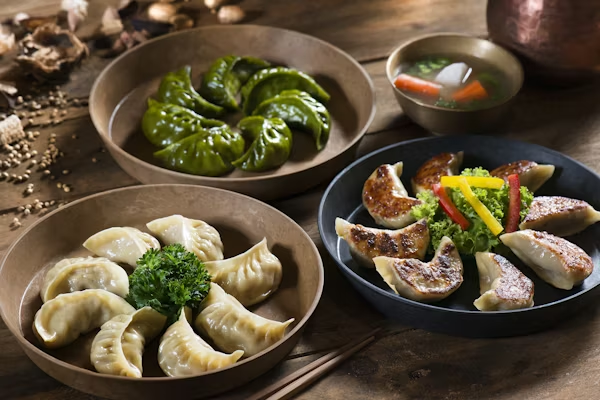Patan is considered as one of the oldest cities in Nepal. It lies just across the Bagmati River from Kathmandu. This ancient city is also called Lalitpur, meaning “City of Fine Arts.” Every corner of Patan reflects its timeless architecture and culture. The streets are narrow but full of life and color. Locals are proud of their heritage and artistry. You will find centuries-old buildings still standing tall. Each step in Patan feels like walking through living history.
Patan Durbar Square is located at the heart of the city. This square is the heart of Patan’s culture and identity. It houses palaces, courtyards, and temples with detailed carvings. Patan Durbar Square is a one of the UNESCO World Heritage Sites of Nepal.
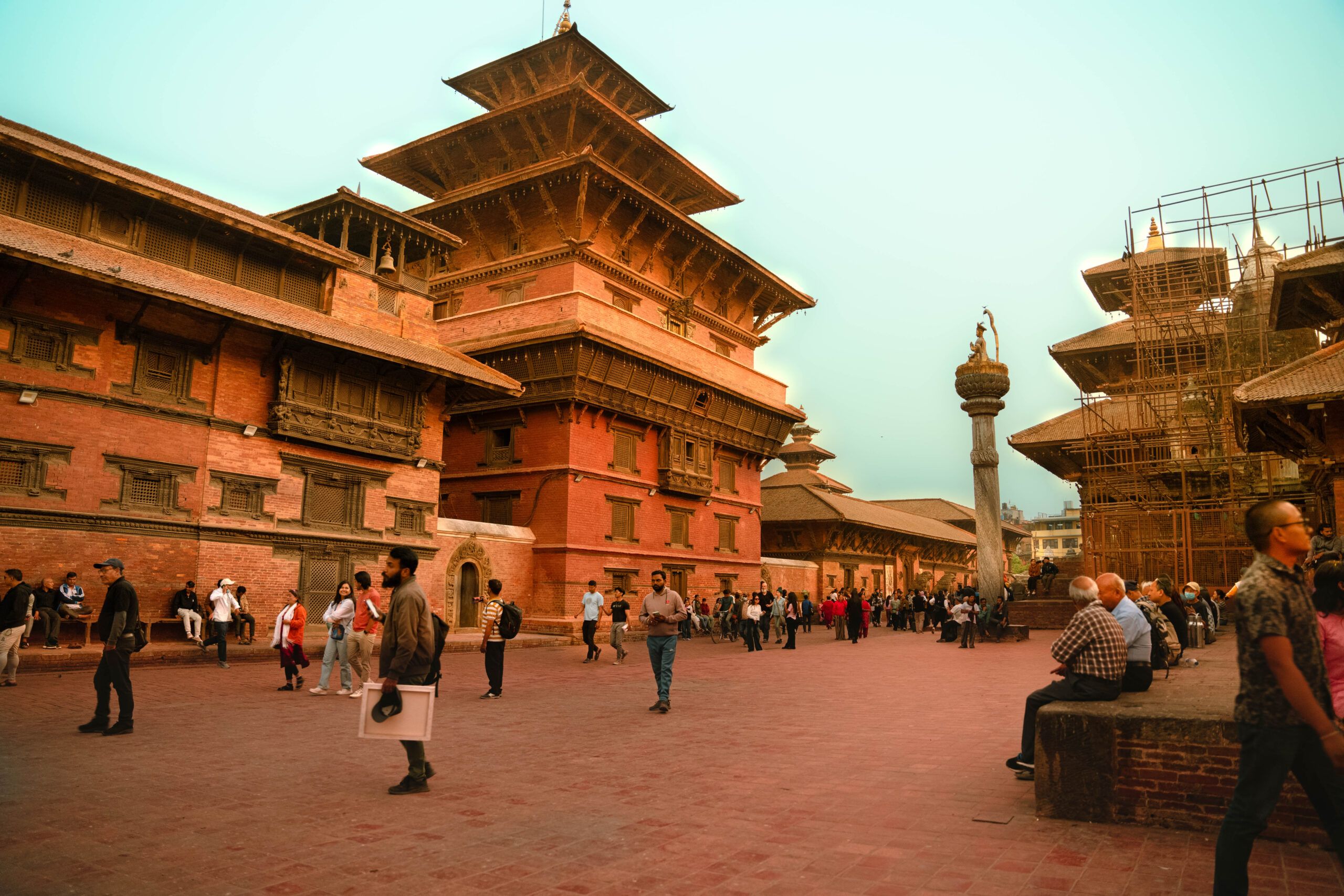
Every structure here tells a story of Nepal’s golden age. You can see both Hindu and Buddhist monuments in one place. The Patan Durbar square remains a place and venue of local festivals and daily rituals. Tourists love its vibrant mix of spirituality and architecture.
The moment you step into Patan Durbar Square, time slows down. The calm atmosphere feels peaceful and grounding. You can hear bells ringing, prayer flags fluttering, and pigeons cooing softly. Nearby, the Patan Museum displays artifacts that tell Nepal’s royal past. Krishna Mandir rises tall with its stunning stone architecture. Local shops sell traditional crafts, artworks, and silver jewelry. Photographers and history lovers find endless inspiration here. Patan Durbar Square is more than a destination; it’s an experience.
History and Origin of Patan
Patan has roots that go back over 2,000 years. Ancient legends say Rishi Yogi named it Lalitpur, the City of Beauty. The city flourished under the rule of the Malla kings. They built temples, palaces, and courtyards that still stand strong. Patan became a cultural and religious venue in the Kathmandu Valley. Skilled artists and metalworkers made it famous across Asia. Patan grew rich in art, craft, and trade during the medieval period. Kings promoted harmony between Hinduism and Buddhism. Locals still honor these traditions with daily rituals. The old city center reflects centuries of history and spiritual depth.

Historians believe Patan was planned with precision. Streets run in straight lines, and temples sit at key points. This layout shows the deep knowledge of ancient city builders and architecture. Patan survived earthquakes, invasions, and political shifts over time. Despite these challenges, its soul and structure stayed strong. Local artisans preserved its art and culture with dedication. Travelers today can still feel that ancient energy. Walking through Patan is like reading a living history book. Every brick and statue holds a piece of the past. Patan stands proud as Nepal’s timeless cultural treasure.
Top 5 Places in Patan to Visit
1. Patan Durbar Square
Patan Durbar Square is the regarded as cultural heart of Lalitpur. This historical site holds palaces, courtyards, and artistic temples. The Malla kings ruled from here during Nepal’s golden age. It reflects the richness of Newar architecture and craft. You can see stone lions, bronze statues, and carved windows. Each detail shares a story of ancient pride and precision. The square remains the soul of Patan city. Visitors often start their journey here.
The royal palace complex i.e Patan Durbar Square shows how kings once lived in Patan. Mul Chowk, Sundari Chowk, and Keshav Narayan Chowk form the palace’s core. Each courtyard has fine wood and stone artwork. A sacred bath called Tusha Hiti is situated in Sundari Chowk. These places highlights the rich lifestyle of Patan’s royal era. The surroundings blend history with calm beauty. You can walk through time with every step.
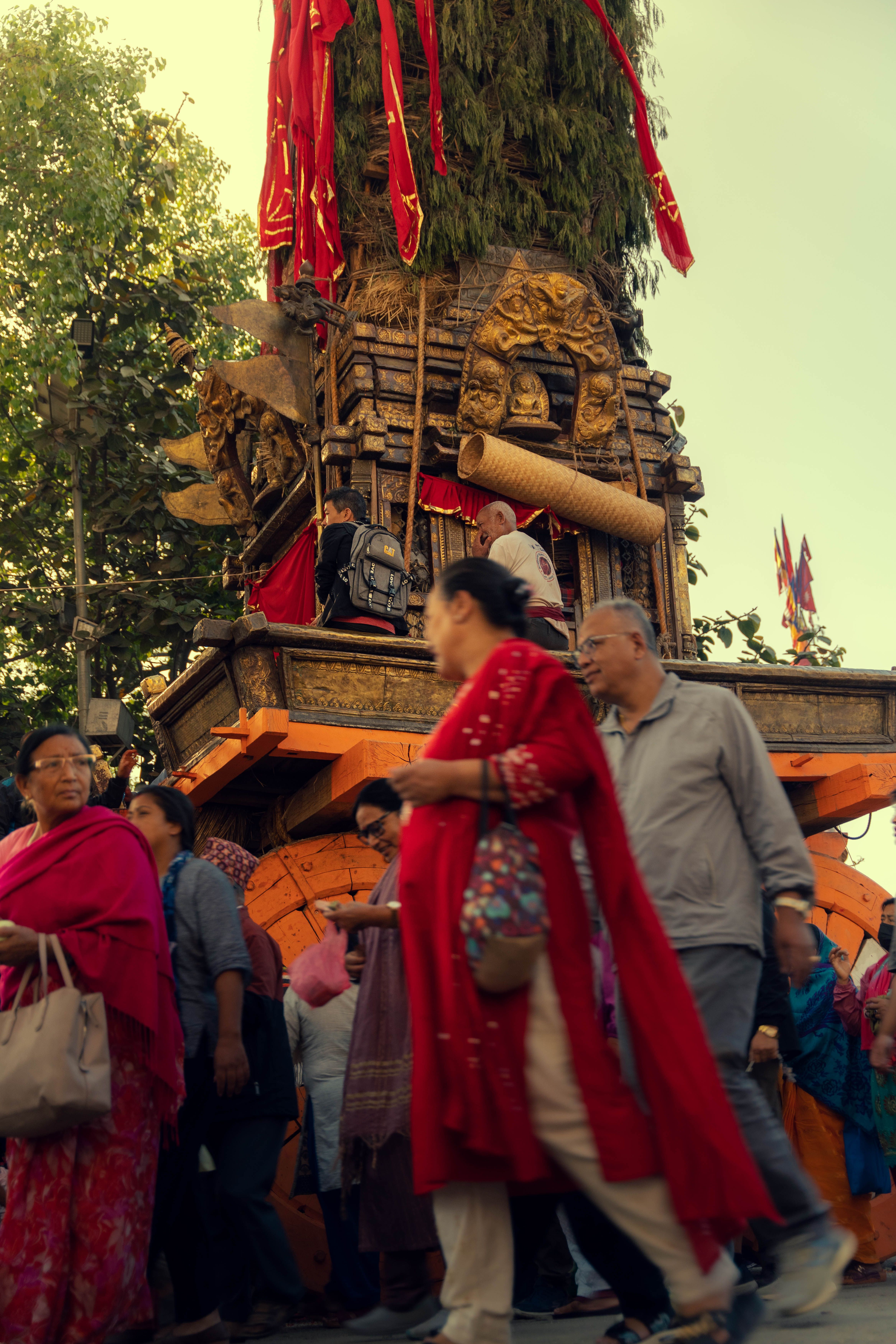
Tourists love the living vibe of Patan Durbar Square. The space hosts daily rituals, prayer offerings, and community gatherings. Pigeons fly freely above red-bricked shrines. Monks chant as incense rises in the air. Photography, architecture, and culture lovers all find something special here. Patan Durbar Square is more than a tourist spot. It’s a great representation into Nepal’s spiritual and artistic past. No Patan visit is complete without it.
2. Krishna Mandir (Krishna Temple)
Krishna Mandir stands proudly inside Patan Durbar Square. It is the most iconic temple built entirely of stone. King Siddhi Narsingh Malla built Krishna Mandir in the 17th century. The temple honors Lord Krishna, a Hindu deity. Each level of the temple has beautiful carvings. Stories from the Mahabharata and Ramayana decorate the walls. Devotees come daily to offer prayers and flowers. It feels both spiritual and grand.
The temple has 21 spires, a rare architectural design. It blends Mughal and Shikhara styles in one structure. The building is made from fine gray stone. Skilled craftsmen shaped each piece by hand. This temple reflects both devotion and design excellence.
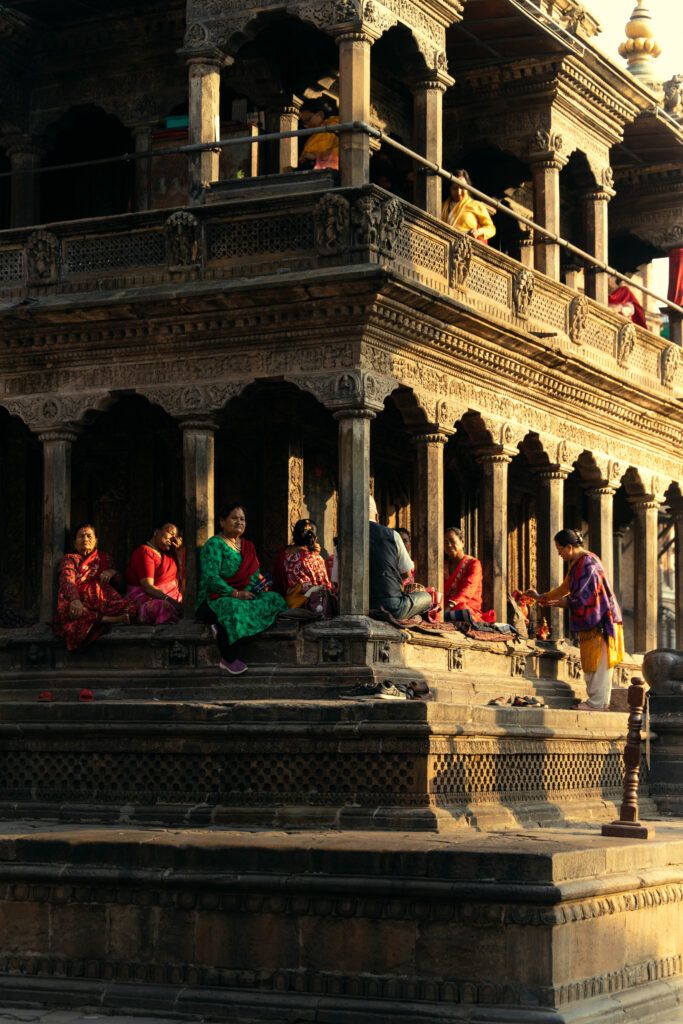
It becomes even more magical during Krishna Janmashtami. Worshippers sing and light oil lamps all night long. The temple glows with energy and color.
Visiting Krishna Mandir connects you to Nepal’s Hindu roots. The calm, rhythmic chants calm your thoughts. Birds sit quietly on its domes as people gather below. Locals tell stories of the temple with pride. This sacred place unites art, faith, and history in one frame. Every visitor remembers its peace and beauty. It’s a highlight of every Patan tour.
3. Patan Museum
Patan Museum sits inside the royal palace near the Durbar Square. UNESCO called it one of the best museums to visit in South Asia. The building itself is centuries old and beautifully restored. Red bricks and carved windows create a timeless mood in the museum. Inside, it holds a vast collection of sacred art. Each artifact shares a story of Nepal’s past. The museum focuses on Hindu and Buddhist symbolism. It guides you through Nepal’s spiritual heritage that inspires us.
Visitors can see bronze idols, ancient coins, and sacred scrolls. Detailed information panels explain each piece clearly. Many items were once part of Patan’s temples and homes. Artists shaped them with great care and values.
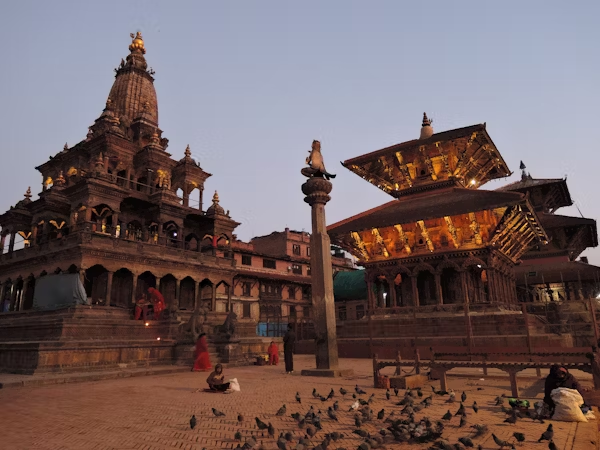
The museum honors both the artists and their beliefs. A quiet courtyard in the center gives you space to reflect. Light falls gently on its peaceful setting. It feels like a sacred pause.
The Patan Museum is perfect for culture lovers. It brings history alive without overwhelming visitors. You learn while enjoying beauty at every turn. Photos are allowed, so memories last longer. Don’t rush—each room deserves time and thought. The museum also hosts different art events and workshops. It adds depth and value to your understanding of Patan Durbar Square. Every traveler should take time to explore it.
4. Golden Temple (Hiranya Varna Mahavihar)
The Golden Temple lies in a hidden alley near Patan Durbar Square. Locals call it “Hiranya Varna Mahavihar.” Th/is sacred Buddhist monastery shines with golden color. It dates back to the 12th century and remains active today. Monks chant and perform rituals here daily. The temple is small but full of spiritual energy. Statues of Buddha and Bodhisattvas fill the altar space. The air smells of incense and devotion.
The temple gate welcomes visitors with detailed carvings. A tortoise rests at the entrance, symbolizing patience and stability. Inside, bronze prayer wheels line the walls.
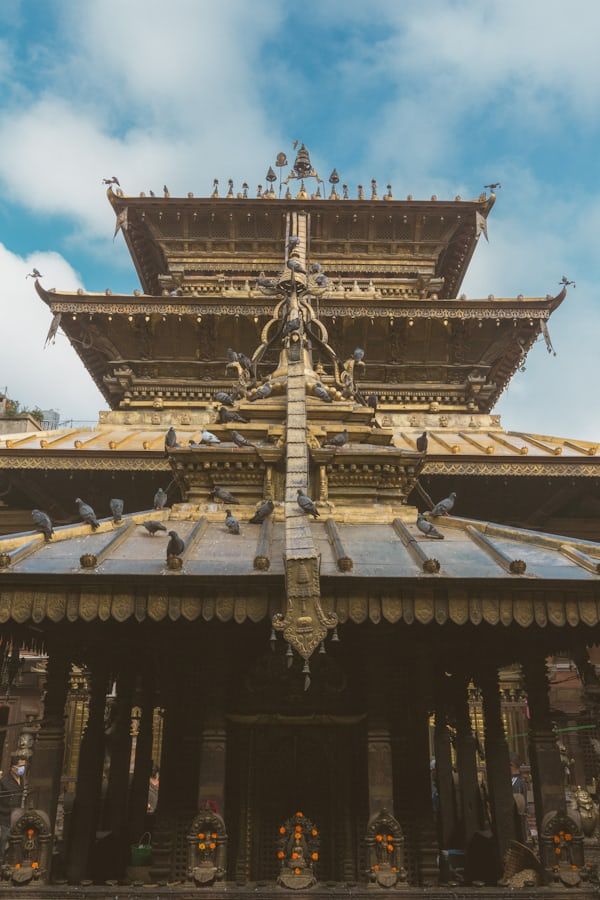
The upper floor holds ancient scriptures and holy objects. Every wall shows artistic excellence in metal and wood. Despite its size, the temple feels rich and deep. Visitors often return for the quiet it offers.
Hiranya Varna Mahavihar is a hidden gem of Patan. Few tourists know about it before arriving. That makes it even more special to visit. It’s a place to pause, breathe, feel still and peace. You can sit beside locals in silent prayer. It teaches the beauty of simplicity. Don’t miss this spiritual corner of Patan. It’s truly a sacred treasure.
5. Patan Pottery Square (Pukhusi Tole)
Patan’s Pottery Square lies in the peaceful neighborhood of Pukhusi Tole. This place brings you closer to Patan’s heritages and cultures. Here, artisans shape clay with their hands and hearts. They make pots, lamps, statues, and everyday items. The process is fully traditional—no machines at all. You’ll see spinning wheels, drying racks, and fired kilns. Elderly potters pass their skills to younger generations. It’s craft and culture in perfect harmony.
The square is open to all visitors. You can watch or even try your hand at making pottery. Locals warmly guide you through the steps. Photography lovers find beauty in every corner. Clay dust rises as hands move in rhythm. The earth, water, and fire connect in one process. It feels ancient and creative at the same time.
Patan Pottery Square shows what makes Patan so special. It blends art with daily life. Every pot has a story behind its shape. The people here keep tradition alive with pride. This spot adds depth to your travel experience. It’s one of the most authentic and interesting corners of Patan. Take home a handmade souvenir if you can. Your visit supports local heritage directly.
Things to do in Patan
1. Explore Patan Durbar Square and Its Courtyards
Start your journey with a walk around Patan Durbar Square. The square offers a mix of history, spirituality, and artistry. Every building showcases Nepal’s best craftsmanship. You’ll see statues, temples, shrines, and palaces. Each courtyard hides unique treasures and carvings. The place is peaceful yet lively with daily rituals. Visit Krishna Mandir and Patan Museum nearby for deeper insight to Nepal’s culture and religions. This walk connects you to the soul and heart of Patan.
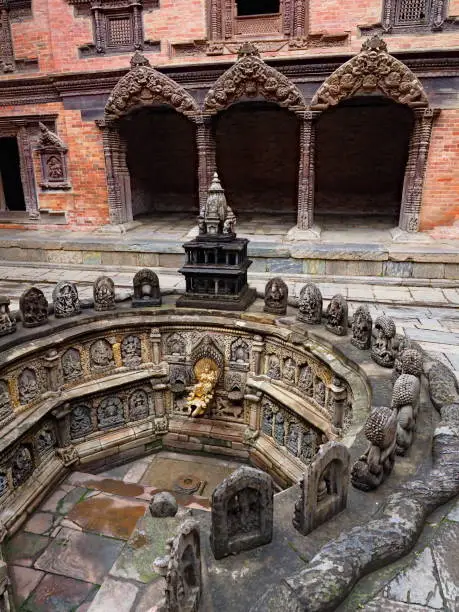
You’ll feel inspired while exploring my-main and its surroundings. Listen to guides share stories of kings and gods. Watch locals perform quiet prayers at sunrise. Take photos of ancient details in wood and stone. Discover hidden gems of Patan within narrow alleys. The entire square feels like a living time capsule. Don’t miss the golden hour light across the temples and squares. This experience is rich, real, and unforgettable.
2. Try Pottery Making at Patan’s Pottery Square
In Patan Pottery Square, you can join a pottery session with locals. Experienced potters guide you step by step. You’ll sit at a spinning wheel and shape your own piece. Children and adults all enjoy this creative activity. It connects you with centuries of tradition. You’ll respect the skill behind every clay item. It’s a highlight among things to do in Patan.
This activity is not just fun—it’s deeply cultural. Pottery in Patan reflects the city’s soul, peace and rhythm. Locals have done this for generations with pride. You feel grounded as your hands touch raw earth. Carry your creation home as a memory. Every spin brings calm, joy, and focus. Don’t miss this hands-on cultural experience.
3. Visit the Patan Museum for Sacred Art and Knowledge
A trip to the Patan Museum is a must for culture lovers and enthusiast. It’s located right inside my-main, making access easy. The museum offers deep insights into Nepal’s spiritual and royal’s history. Each item tells a story through sacred art. Bronze statues, ancient coins, and temple objects fill the rooms. The peaceful setting enhances the learning experience. Signs explain everything clearly for foreign visitors. It’s both educational and beautiful.
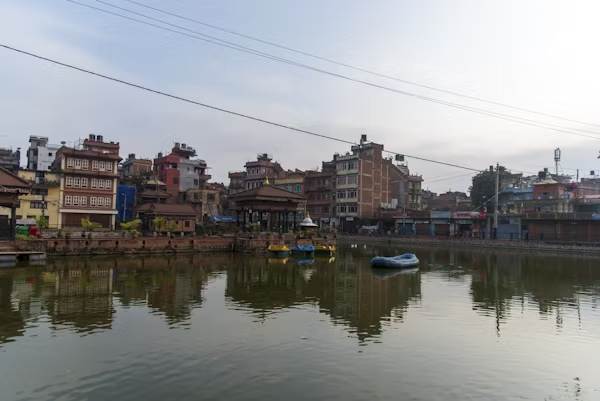
Take time to explore each room without rushing. The exhibits focus on Hindu and Buddhist traditions. You’ll see rare forms of deities and ritual tools. Visit the inner courtyard for a quiet break. Photographers love the museum’s lighting and setting. You’ll leave with knowledge and appreciation. This museum highlights the culture of Patan. Don’t miss this timeless treasure.
4. Attend Local Festivals Around Patan Durbar Square
Plan your visit during one of Patan’s grand festivals. The entire my-main turns into a celebration space. Events like Rato Machhindranath Jatra are full of energy. Locals pull giant chariots through the streets. Music, color, and devotion fill the air. Temples glow with lights and decorations. You’ll see how culture of Patan lives on today. Visitors feel lucky to witness these moments.
Joining these events is a way to connect with people. You learn traditions by living them, not just reading. Everyone celebrates together with smiles and chants. It’s a truly human experience. Even as a tourist, you feel part of it. Festivals add soul to your Patan visit. Each celebration honors the history of Patan. Time your trip right for the full experience.
5. Discover Hidden Alleys and Artistic Workshops
Walk away from the main roads and explore Patan’s back alleys. You’ll find hidden gems of Patan in quiet corners. Discover secret temples, old houses, and calm courtyards. Local artists work in tiny studios along the way. Watch them create metal crafts, thangka paintings, and wood carvings. These workshops preserve the spirit of ancient skills. Take time to talk to the artists if you have privilege of time. You’ll be fascinated at their stories and passion.
This walk shows you the real face of Patan. It’s peaceful, creative, and deeply human. Every corner has something special to see. No big crowds, just quiet discovery. These workshops reflect the culture of Patan today that we see. Buy a souvenir made with heart and history. You support local families directly. This is Patan beyond the guidebooks.
Best Season to Visit Patan
The best time to travel Patan is from October to March. During this period, the weather stays cool, dry, and clear. Skies remain bright blue, perfect for sightseeing and photography. This season brings out the beauty of Patan Durbar Square. You can enjoy festivals, rituals, and peaceful walks in pleasant weather. The temples and stone carvings glow under soft sunlight. Air quality is better than other time, and visibility is high. Everything feels calm and welcoming in these months.
This season also includes major cultural events in Patan. You can witness local celebrations and feel the real culture of Patan. Streets fill with music, lights, and cheerful crowds and fills lively. Artisans open their shops and work outdoors in the sun. Exploring Patan Museum and Krishna Mandir becomes more comfortable. Even walking through hidden gems of Patan feels special. You can try local street food without worry of rain. This season offers the perfect balance of comfort, culture, and charm.
Culture of Patan
The culture of Patan is a blend of Hindu and Buddhist traditions. Temples and monasteries sit side by side in harmony. Locals follow age-old rituals in their daily lives. Every morning, people light lamps and offer flowers to gods and worship them. Festivals bring streets to life with music and color. Families gather, share food, and honor their deities. Art and faith walk hand in hand here. Culture in Patan isn’t just history—it’s alive and breathing.
Newar communities form the cultural core of Patan. Their language, food, dress, and festivals shape daily life. You can see artisans creating metalwork and wood carvings in old alleys. These crafts reflect deep spiritual and artistic meaning. Traditional dances and music fill the air during ceremonies. Locals celebrate their past with pride and passion. Visiting Patan means joining a living cultural world. Every moment teaches something beautiful and real.
Cuisines to Try At Patan
1. Newari Khaja Set (Samay Baji)
The Newari Khaja Set, also known as Samay Baji, is a must-try dish in Patan. It includes beaten rice, black soybeans, boiled egg, spiced potato, fried fish and buffalo meat. This dish represents a complete blend of taste and culture. Each item has a symbolic meaning in Newar rituals. Locals serve it during festivals, family events, and special gatherings. The textures and flavors vary in every bite. It’s light, healthy, and full of heritage. You can find it in many local eateries near Patan Durbar Square which sells Samay Baji.
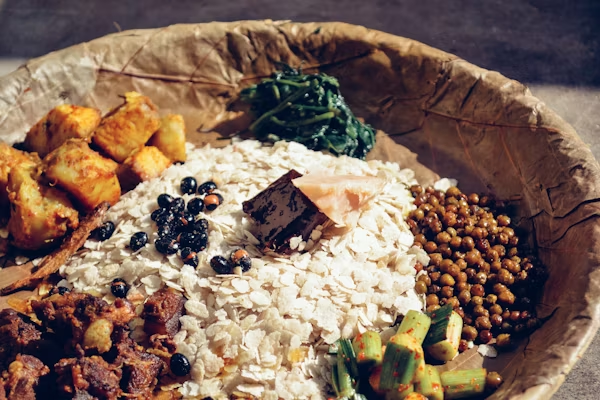
Eating Samay Baji connects you to the culture of Patan. The dish offers a balance of salty, spicy, and crunchy flavors. It’s served on brass plates with traditional styling. Locals take pride in how they prepare and present it. Many restaurants serve Samay Baji with local liquors. This dish feels more than a meal—it feels like tradition. Trying this cuisine makes your trip more authentic. You’ll remember its taste long after you leave.
2. Chatamari (Newari Pizza)
Chatamari is a popular street food in Patan, often called “Newari Pizza.” It’s made from rice flour batter and cooked like a thin pancake. Toppings include minced meat, eggs, vegetables, and spices. It’s crisp around the edges and soft in the center. Locals eat it during casual meals and small feasts. You can watch it being cooked fresh in open kitchens. The aroma itself will pull you toward it. It’s quick, delicious, and full of local flavor.
Chatamari is light yet satisfying and easy to eat on the go. You can pair it with local chutneys or spiced pickles. The dish feels both modern and traditional. It reflects how culture of Patan adapts creatively. Children and adults both enjoy this flavorful snack. You’ll find it in hidden alley stalls and rooftop cafés. Don’t leave Patan without trying this tasty favorite.
3. Yomari
Yomari is a sweet dumpling made from rice flour and filled with jaggery and sesame seeds. It’s steamed and shaped like a pointed fig. This dessert holds a sacred place in Newar culture. It is traditionally made during Yomari Punhi, a local festival of Newari Community. The filling melts in your mouth with a rich, warm and sweet. Patan’s locals believe it brings good luck and blessings. The dish feels festive, even when eaten casually. You’ll love it if you enjoy sweet, soft bites.
Yomari tastes like comfort and tradition rolled into one. You can find it in small local kitchens during the winter months. It’s best when eaten hot and fresh. Locals will often offer it with warm tea. Children especially love its shape and flavor. This dish speaks to the heart of Patan’s culture. Eating Yomari lets you taste both joy and history. Try it once, and it’ll definitely become a favorite.
4. Juju Dhau (King of Yogurt)
Juju Dhau means “King of Yogurt” in Newari language (one of local language in Patan). It’s thick, creamy, and served in clay pots. Originally made in nearby Bhaktapur, it’s popular throughout Patan too. Local vendors bring it fresh to Patan Durbar Square every day. The taste is rich and slightly sweet with a natural yogurt tang. Locals enjoy it after meals or during festivals. The clay pot keeps it cool and fresh longer. You can’t visit Patan without tasting this local treasure.
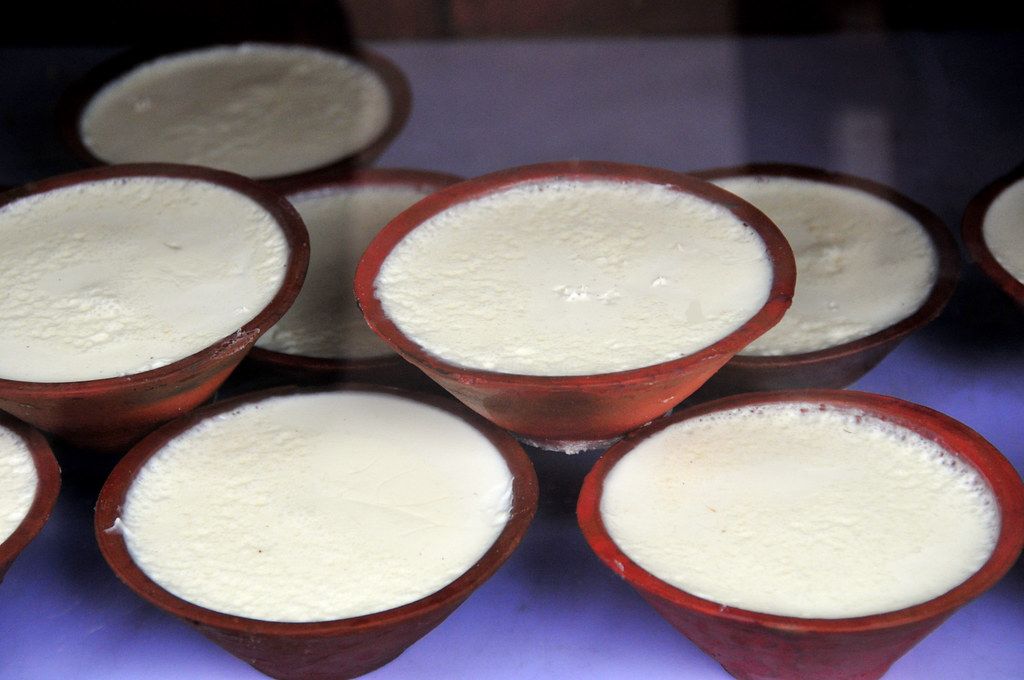
Juju Dhau is more than just dessert—it’s tradition in every spoon. You’ll see it served at weddings, feasts, and temple offerings. The flavor is naturally delightful and refreshing. It feels special because it’s handmade with care. The creamy texture melts softly in your mouth with great taste. Many travelers say it’s the best yogurt they’ve ever had. This simple dish shows the unique charm of culture of Patan. Don’t miss this royal treat.
5. Aloo Tama (Potato and Bamboo Shoot Curry)
Aloo Tama is a flavorful curry made from potatoes and fermented bamboo shoots. The dish has a tangy, spicy taste that’s deeply comforting. Locals love it for both daily meals and family feasts. It pairs well with beaten rice, steamed rice or roti. The unique sourness from the bamboo makes it more tasty. The dish is vegetarian, but rich in flavor and tradition. Restaurants in Patan serve it in traditional bowls with local spices. It’s a favorite among both locals and tourists.
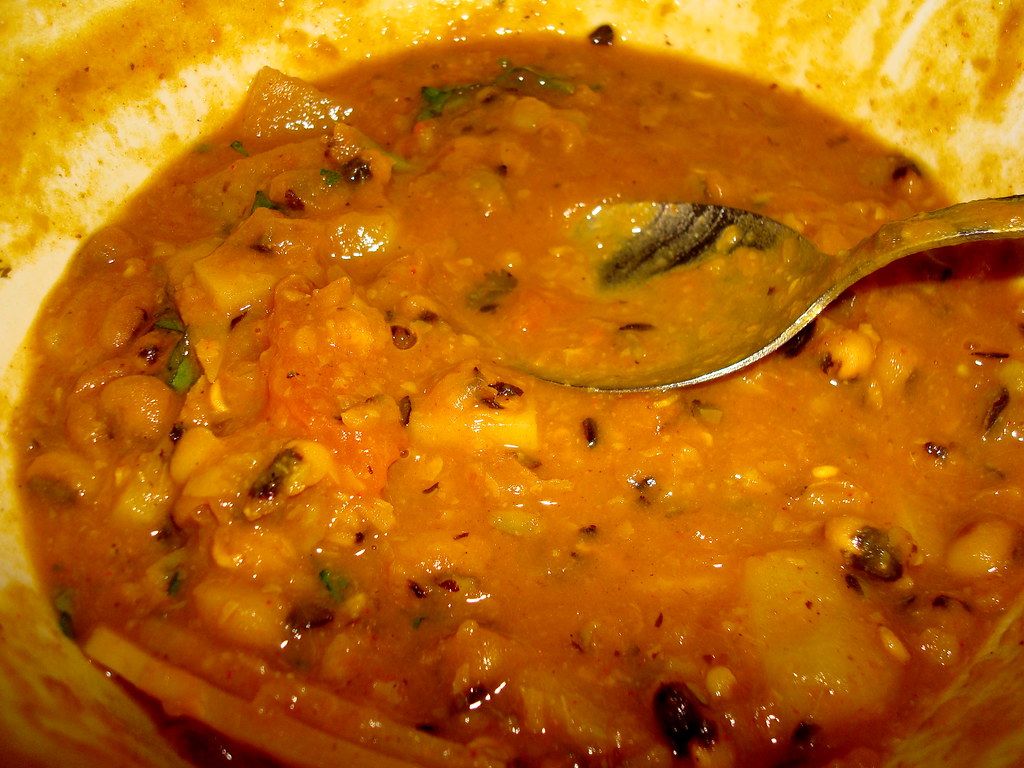
Eating Aloo Tama connects you with the flavors of the Kathmandu Valley. It’s part of Newari households and street-side eateries alike. The curry reflects how simple ingredients create bold flavors. If you love trying earthy, homestyle food, this is ideal. Locals say it brings warmth during colder seasons. The dish represents comfort and heritage in every spoon. Aloo Tama is another reason why Patan is famous for its food culture. Try it for a spicy and soulful experience.
Why is Patan Famous?
Patan is famous for its rich history, sacred temples, local cuisines and timeless craftsmanship. The centerpiece, Patan Durbar Square, reflects the city’s royal past and artistic glory. Visitors admire the detailed stone carvings, courtyards, and sacred shrines. The city’s spiritual harmony between Hinduism and Buddhism makes it unique. It is also home to iconic historical landmarks like Krishna Mandir and the Patan Museum. Everywhere you walk, you see culture living and breathing. The city still follows ancient rituals and festivals. This deep cultural soul is why Patan stays unforgettable.
Patan also stands out for its skilled artisans and vibrant food culture. Locals keep centuries-old techniques alive in metalwork, pottery, and wood carving. Handmade items fill hidden workshops and open markets in Patan. The city’s traditional dishes like Samay Baji, Chatamari, and Juju Dhau offer bold local flavors. Patan also draws visitors with its calm atmosphere and friendly community. It’s a perfect mix of tradition, taste, and spiritual beauty. From festivals to daily life, everything feels real and rooted. Patan truly shines as Nepal’s cultural capital.
Final Thoughts
Patan is more than just a city—it’s a living museum of Nepal’s heart and heritage. From the stunning beauty of Patan Durbar Square to the sacred calm of Krishna Mandir, every place tells a story. You’ll walk through history, culture, and devotion in every alley. The detailed art in Patan Museum reveals how rich the past truly was. Whether you’re watching potters work or tasting traditional dishes, the experience feels real and personal. The culture of Patan stands strong in daily life, not just in books. Exploring Patan means discovering both old wonders and warm people. No visit to Nepal is complete without seeing this cultural jewel.
Come for the temples, stay for the stories. Let the city’s charm and craft take your breath away. Capture the rhythm of local life and quiet prayer. Feel the textures of stone, metal, and handmade cloth. Patan connects you to something ancient yet alive. It’s not just about seeing—it’s about feeling. You’ll carry its peace and energy long after you leave. That is the magic of Patan, and why it truly matters.
